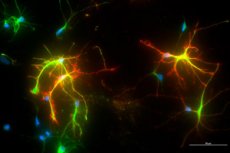
一种模拟蛋白质行为的新型纳米材料或能有效治疗阿尔茨海默病和其他神经退行性疾病。这种纳米材料能够改变脑细胞中两种关键蛋白质之间的相互作用,从而产生强大的治疗效果。
这一创新成果最近发表在《先进材料》杂志上,是由威斯康星大学麦迪逊分校的科学家和西北大学的纳米材料工程师合作完成的。
这项工作的重点是改变两种被认为与阿尔茨海默病、帕金森病和肌萎缩侧索硬化症 (ALS) 等疾病发展有关的蛋白质之间的相互作用。
第一种蛋白质叫做 Nrf2,它是一种特殊类型的蛋白质,称为转录因子,可以在细胞内开启和关闭基因。
Nrf2 的重要功能之一是其抗氧化作用。尽管不同的神经退行性疾病源于不同的病理过程,但它们都因氧化应激对神经元和其他神经细胞的毒性作用而共同存在。Nrf2 能够对抗脑细胞中的这种毒性应激,从而有助于预防疾病的发展。
威斯康星大学麦迪逊分校药学院教授杰弗里·约翰逊和他的妻子、该校高级研究员德琳达·约翰逊几十年来一直在研究Nrf2,将其作为治疗神经退行性疾病的有希望的靶点。2022年,约翰逊夫妇及其同事发现,提高特定类型脑细胞——星形胶质细胞——中Nrf2的活性,有助于保护阿尔茨海默病小鼠模型中的神经元,从而显著减少记忆丧失。
尽管先前的研究表明增加 Nrf2 活性可能是治疗阿尔茨海默病的基础,但科学家们一直难以有效地针对大脑中的蛋白质。
杰弗里·约翰逊说:“药物很难进入大脑,但找到能够激活 Nrf2 而又没有太多副作用的药物也很困难。”
如今,一种新型纳米材料问世了。这种合成材料被称为类蛋白质聚合物(PLP),旨在像蛋白质本身一样与蛋白质结合。这种纳米级模拟物是由西北大学化学教授、该校国际纳米科学研究所成员内森·詹内奇(Nathan Giannenchi)领导的团队研发的。
Giannecchi 设计了几种针对不同蛋白质的 PLP。这种特殊的 PLP 旨在改变 Nrf2 与另一种名为 Keap1 的蛋白质之间的相互作用。这些蛋白质(或通路)之间的相互作用是治疗多种疾病的已知靶点,因为 Keap1 控制着 Nrf2 何时响应和对抗氧化应激。在正常情况下,Keap1 和 Nrf2 是关联的,但在应激状态下,Keap1 会释放 Nrf2 来发挥其抗氧化功能。
“就在一次谈话中,内森和他在格罗夫生物制药公司(Grove Biopharma,一家专注于蛋白质相互作用治疗靶向的初创公司)的同事们向罗伯特提到,他们计划以Nrf2为靶点,”约翰逊说。“罗伯特说,‘如果你打算这么做,你应该打电话给杰夫·约翰逊。’”
很快,约翰逊和詹内奇就开始讨论威斯康星大学麦迪逊分校实验室提供测试詹内奇纳米材料所需的小鼠模型脑细胞的可能性。
杰弗里·约翰逊表示,他最初对 PLP 方法有些怀疑,因为他不熟悉这种方法,而且精确瞄准脑细胞中的蛋白质通常比较困难。
“后来,内森的一个学生来到这里,用它研究我们的细胞,结果,效果真的非常好,”他说,“之后我们就深入研究了。”
研究发现,Giannecchi 的 PLP 能够高效结合 Keap1,释放 Nrf2 使其在细胞核中积累,从而增强其抗氧化功能。重要的是,它不会产生干扰其他 Nrf2 激活策略的副作用。
尽管这项工作是在培养细胞上完成的,但约翰逊和吉安内基现在计划在神经退行性疾病的小鼠模型上进行类似的研究,这是他们原本没有想到要进行但现在很兴奋的研究方向。
“我们缺乏生物材料方面的专业知识,”德琳达·约翰逊说道,“因此,从西北大学获得这项技术,然后在威斯康星大学进一步发展生物学领域,表明这类合作非常重要。”

